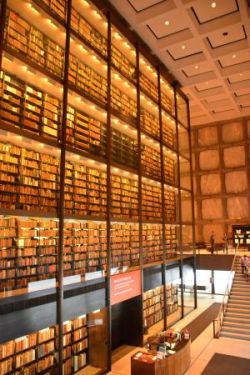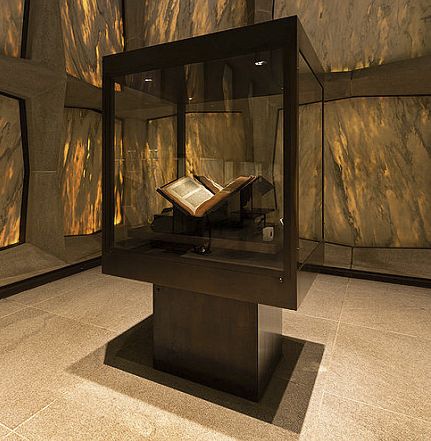I was born in Mainz, Germany. I lived for the first month of my life in a printing plant before being brought to a merchant. I can remember very little about that time, for as soon as I left the plant I was securely stored away in a bookcase outside of town. I was very fortunate to escape the 1462 ruthless plundering of Mainz carried out by the troops of Adolph II. Many of my fellow “paperkind” were destroyed the day that the printing office, the place of my birth, was set on fire, taking all of my early childhood memories away from me.
While I was created with a chance to live forever, (whatever “forever” entails on this planet), it is quite possible that improper living conditions could bring premature end of life to a great number of we “paperkinds.” For quite a few of us lucky ones, who manage to attain collectible status and avoid mishaps on the way, life can be long, long, long. Some of my siblings are accounted for and well-preserved, but perhaps there are still a few that have not been destroyed and are still intelligible, buried in the farthest corners of the world, and hidden amongst the innermost shadows of forgotten rooms, waiting for the day to be discovered.
As for myself, I am sitting pretty in the most elegant of rooms, under the most proper conditions created to house “paperkinds”. I am here with some other lucky, collectible, all-time “nuggets”, such as; The Bay Psalm Book which was bought by Cornelius Vanderbilt and somehow made its way to Yale. I was still far across the Atlantic, the day when locksmith Stephen Daye, set up shop in 1639, in Cambridge MA, to work on the production of The Whole Booke of Psalmes, psalter, commonly known as the Bay Psalm Book, prized as the oldest surviving object printed in what is now the United States.
Every work in this place, whether sacred or secular, was laboriously created as a unique glorification of the acquisition of knowledge. Take for example, John James Audubon’s, The Birds of America; or the Speculum humanae salvationis (pseudo-Bonavature, Meditations de passion Christi, England, early fifteen century), believed to be the first illuminated manuscript given to an American academic library; or the first edition of John Milton’s Paradise Lost; or the multiple copies of rare James Joyce’s, Ulysses; or the papers of Langston Hughes, Ezra Pound and Lassie creator Eric Knight. They are all here.
Thanks to architect Gordon Bunshaft, our state of the art new digs at the Beinecke Rare Book and Manuscript Library, is providing the ideal 65 °F and 45% humidity for we “paperkinds,” despite seasonal fluctuations, while also protecting us from bookworms. I am also informed that the plumbing, fire-suppression and security in this place, are designed to ensure our eternal lives, or at least as long as this planet keeps spinning.
Since I am not allowed to remain uncommunicative and inaccessible, and I do have to make myself available to the young knowledgeable scholars, I am snuggly housed in a nice Bunshaft-designed display case; an additional precaution offered to super stars such as me. Oh, before I forget, a little piece of information for any newcomers planning to join the establishment, you will have to spend three days in an on-site freezer at 30 degrees below zero Celsius to exterminate any pests you may be carrying and stabilize your mold. A brilliant idea, may I add. In fact I do not understand why some of our visitors are not forced to go through a similar process.
Just in case you are still wondering who I am, I am the Gutenberg Bible, also known as the 42-line Bible, the Mazarin Bible or the B42.


{ 0 comments… add one now }